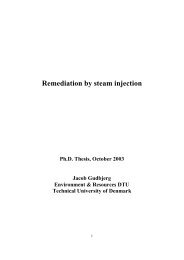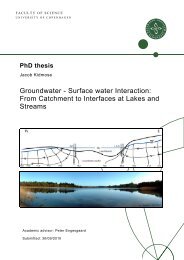Groundwater arsenic in the Red River delta, Vietnam ... - Fiva
Groundwater arsenic in the Red River delta, Vietnam ... - Fiva
Groundwater arsenic in the Red River delta, Vietnam ... - Fiva
Create successful ePaper yourself
Turn your PDF publications into a flip-book with our unique Google optimized e-Paper software.
Controll<strong>in</strong>g geological and hydrogeological processes <strong>in</strong> an <strong>arsenic</strong><br />
contam<strong>in</strong>ated aquifer on <strong>the</strong> <strong>Red</strong> <strong>River</strong> flood pla<strong>in</strong>, <strong>Vietnam</strong><br />
Flemm<strong>in</strong>g Larsen a, *, Nhan Quy Pham b , Nhan Duc Dang c , Dieke Postma a , Søren Jessen d ,<br />
Viet Hung Pham e , Thao Bach Nguyen b , Huy Duc Trieu b , Luu Thi Tran e , Hoan Nguyen b ,<br />
Julie Chambon d , Hoan Van Nguyen b , Dang Hoang Ha b , Nguyen Thi Hue e , Mai Thanh Duc e ,<br />
Jens Christian Refsgaard a<br />
a<br />
Geological Survey of Denmark and Greenland (GEUS), Østervoldgade 10, DK-1350 Copenhagen K, Denmark<br />
b<br />
Hanoi University of M<strong>in</strong><strong>in</strong>g and Geology, Viet Nam<br />
c<br />
Institute for Nuclear Science and Technology, Viet Nam<br />
d<br />
Institute of Environment and Resources, Technical University of Denmark, Denmark<br />
e<br />
Research Centre for Environmental Technology and Susta<strong>in</strong>able Development (CETASD), Hanoi University of Science, VNU, Viet Nam<br />
article <strong>in</strong>fo<br />
Article history:<br />
Available onl<strong>in</strong>e 4 July 2008<br />
* Correspond<strong>in</strong>g author.<br />
E-mail address: flar@geus.dk (F. Larsen).<br />
abstract<br />
0883-2927/$ - see front matter Ó 2008 Elsevier Ltd. All rights reserved.<br />
doi:10.1016/j.apgeochem.2008.06.014<br />
Applied Geochemistry 23 (2008) 3099–3115<br />
Contents lists available at ScienceDirect<br />
Applied Geochemistry<br />
journal homepage: www.elsevier.com/locate/apgeochem<br />
Geological and hydrogeological processes controll<strong>in</strong>g recharge and <strong>the</strong> mobilization of As<br />
were <strong>in</strong>vestigated <strong>in</strong> a shallow Holocene aquifer on <strong>the</strong> <strong>Red</strong> <strong>River</strong> flood pla<strong>in</strong> near Hanoi,<br />
<strong>Vietnam</strong>. The geology was <strong>in</strong>vestigated us<strong>in</strong>g surface resistivity methods, geophysical<br />
borehole logg<strong>in</strong>g, drill<strong>in</strong>g of boreholes and <strong>in</strong>stallation of more than 200 piezometers.<br />
Recharge processes and surface–groundwater <strong>in</strong>teraction were studied us<strong>in</strong>g (i) time-series<br />
of hydraulic head distribution <strong>in</strong> surface water and aquifers, (ii) <strong>the</strong> stable isotope composition<br />
of waters and (iii) numerical groundwater model<strong>in</strong>g. The <strong>Red</strong> <strong>River</strong> and two of its<br />
distributaries run through <strong>the</strong> field site and control <strong>the</strong> groundwater flow pattern. For most<br />
of <strong>the</strong> year, <strong>the</strong>re is a regional groundwater flow towards <strong>the</strong> <strong>Red</strong> <strong>River</strong>. Dur<strong>in</strong>g <strong>the</strong> monsoon<br />
<strong>the</strong> <strong>Red</strong> <strong>River</strong> water stage rises up to 6 m and stalls <strong>the</strong> regional groundwater flow.<br />
The two distributaries recharge <strong>the</strong> aquifer from perched water tables <strong>in</strong> <strong>the</strong> dry season,<br />
whilst <strong>in</strong> <strong>the</strong> flood<strong>in</strong>g period surface water enters <strong>the</strong> aquifer through highly permeable<br />
bank sediments. The result is a dynamic groundwater flow pattern with rapid fluctuations<br />
<strong>in</strong> <strong>the</strong> groundwater table. A transient numerical model of <strong>the</strong> groundwater flow yields an<br />
average recharge rate of 60–100 mm/a through <strong>the</strong> conf<strong>in</strong><strong>in</strong>g clay, and a total recharge of<br />
approximately 200 mm/a was estimated from 3 H/ 3 He dat<strong>in</strong>g of <strong>the</strong> shallow groundwater.<br />
Thus <strong>in</strong> <strong>the</strong> model area, recharge of surface water from <strong>the</strong> river distributaries and recharge<br />
through a conf<strong>in</strong><strong>in</strong>g clay is of <strong>the</strong> same magnitude, be<strong>in</strong>g on average around 100 mm/a. The<br />
thickness of <strong>the</strong> conf<strong>in</strong><strong>in</strong>g clay varies between 2 and 10 m, and affects <strong>the</strong> recharge rate and<br />
<strong>the</strong> transport of electron acceptors (O2, NO3and SO 2<br />
4 ) <strong>in</strong>to <strong>the</strong> aquifer. Where <strong>the</strong> clay<br />
layer is th<strong>in</strong>, an up to 2 m thick oxic zone develops <strong>in</strong> <strong>the</strong> shallow aquifer. In <strong>the</strong> oxic zone<br />
<strong>the</strong> As concentration is less than 1 lg/L but <strong>in</strong>creases <strong>in</strong> <strong>the</strong> reduced zone below to 550 lg/<br />
L. In <strong>the</strong> Holocene aquifer, As is mobilized at a rate of around 14 lg/L/a. An As mass balance<br />
for <strong>the</strong> field site shows that around 1100 kg of As is annually leached from <strong>the</strong> Holocene<br />
sand and discharged <strong>in</strong>to <strong>the</strong> <strong>Red</strong> <strong>River</strong>, correspond<strong>in</strong>g to 0.01% of <strong>the</strong> total pool of As<br />
now present <strong>in</strong> <strong>the</strong> Holocene sand.<br />
Ó 2008 Elsevier Ltd. All rights reserved.





